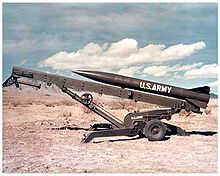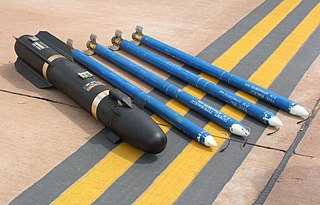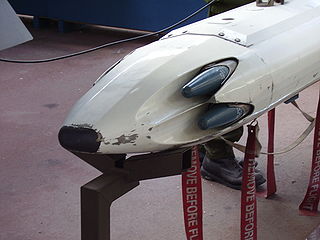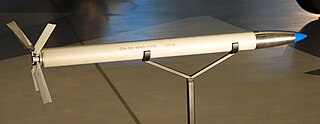
The MGR-3 Little John was a free flight artillery rocket system designed and put into service by the U.S. Army during the 1950s and 1960s.

The MGR-3 Little John was a free flight artillery rocket system designed and put into service by the U.S. Army during the 1950s and 1960s.

Carried on the XM34 rocket launcher, it could carry either nuclear or conventional warheads. It was primarily intended for use in airborne assault operations and to complement the heavier, self-propelled MGR-1 Honest John rocket. Development of the missile was started at Army's Rocket and Guided Missile Agency laboratory at Huntsville, Alabama, the Redstone Arsenal, in June 1955.
In June 1956, the first launch of the XM47 Little John occurred. This initial model was spin-stabilised by larger triangular fins and a longer launch rail. It was stabilised by the fins alone until it began to spin. The production XM51 version had smaller rectangular fins, too small to stabilise the rocket, and was stabilised from launch by a unique "spin-on-straight-rail" system.
The XM51 Little John was delivered to the field in November 1961 and remained in the regular Army's weapons inventory until August 1969. [1] [2]
It was a spin-stabilized field artillery rocket that followed a ballistic trajectory to ground targets. The rocket XM51 consisted of a warhead, a rocket motor assembly, and an igniter assembly. The components were shipped in separate containers, with the warhead and motor assembled before issue and the igniter inserted immediately before use. [1]
The Little John differs from the Honest John in not only its size but how it is stabilized in flight. The flight of the Honest John is stabilized by a spin that is imparted to the rocket by spin rockets after the round leaves the launcher. The XM51 Little John rocket flight is stabilized by applying spin to the rocket while on the launcher, just before firing. This manual method of stabilization was called "spin-on-straight-rail" (SOSR). [1] A hand-wound mechanical clock spring on the launcher rotates the missile through gears, when the firing lanyard is pulled. Once the rocket is rotating at 31⁄2 rev. per second, inertial switches connect the thermal batteries to the rocket motor's igniter. [1] In flight, the spin is maintained by canted fins. The system was manufactured by the Douglas Aircraft Company.
The missile and launcher system were light enough to be easily transported by helicopters and other aircraft or towed by a vehicle. The Phase II Little John weapon system was initially deployed with the 1st Missile Battalion, 57th Field Artillery in Okinawa, Japan.
The missile was retired beginning in July, 1967, with the final missile removed from inventory in 1970. Five hundred missiles were produced during the life of the weapon program. [3]

The MGM-31A Pershing was the missile used in the Pershing 1 and Pershing 1a field artillery missile systems. It was a solid-fueled two-stage theater ballistic missile designed and built by Martin Marietta to replace the PGM-11 Redstone missile as the primary nuclear-capable theater-level weapon of the United States Army and replaced the MGM-1 Matador cruise missiles operated by the German Air Force. Pershing later replaced the European-based MGM-13 Mace cruise missiles deployed by the United States Air Force and the German Air Force. Development began in 1958, with the first test missile fired in 1960, the Pershing 1 system deployed in 1963 and the improved Pershing 1a deployed in 1969. The U.S. Army replaced the Pershing 1a with the Pershing II Weapon System in 1983 while the German Air Force retained Pershing 1a until all Pershings were eliminated in 1991. The U.S. Army Missile Command (MICOM) managed the development and improvements while the Field Artillery Branch deployed the systems and developed tactical doctrine.

The Hydra 70 rocket is a 2.75-inch (70 mm) diameter fin-stabilized unguided rocket used primarily in the air-to-ground role. It can be equipped with a variety of warheads, and in more recent versions, guidance systems for point attacks. The Hydra is widely used by US and allied forces, competing with the Canadian CRV7, with which it is physically interchangeable.

Nuclear artillery is a subset of limited-yield tactical nuclear weapons, in particular those weapons that are launched from the ground at battlefield targets. Nuclear artillery is commonly associated with shells delivered by a cannon, but in a technical sense short-range artillery rockets or tactical ballistic missiles are also included.

The FGM-148 Javelin, or Advanced Anti-Tank Weapon System-Medium (AAWS-M), is an American-made man-portable anti-tank system in service since 1996, and continuously upgraded. It replaced the M47 Dragon anti-tank missile in US service. Its fire-and-forget design uses automatic infrared guidance that allows the user to seek cover immediately after launch, in contrast to wire-guided systems, like the system used by the Dragon, which require a user to guide the weapon throughout the engagement. The Javelin's high-explosive anti-tank (HEAT) warhead can defeat modern tanks by top attack, hitting them from above, where their armor is thinnest, and is also useful against fortifications in a direct attack flight.

A mortar is usually a simple, lightweight, man-portable, muzzle-loaded weapon, consisting of a smooth-bore metal tube fixed to a base plate with a lightweight bipod mount and a sight. They launch explosive shells in high-arcing ballistic trajectories. Mortars are typically used as indirect fire weapons for close fire support with a variety of ammunition.

The CRV7, short for "Canadian Rocket Vehicle 7", is a 2.75-inch (70 mm) folding-fin ground attack rocket produced by Bristol Aerospace in Winnipeg, Manitoba. It was introduced in the early 1970s as an upgraded version of the standard U.S. 2.75-inch air-to-ground rockets. It was the most powerful weapon of its class, the first with enough energy to penetrate standard Warsaw Pact aircraft hangars. The CRV7 remains one of the most powerful air-to-ground attack rockets to this day, and has slowly become the de facto standard for Western-aligned forces outside the United States. Beginning in 2021, 83,303 stored Canadian CRV7s are slated for disposal having been removed from service from 2005 to 2007.

The M270 Multiple Launch Rocket System is an American-developed armored, self-propelled, multiple rocket launcher.
Blue Water was a British battlefield nuclear missile of the early 1960s, intended to replace the MGM-5 Corporal, which was becoming obsolete. With roughly the same role and range as Corporal, Blue Water was a far simpler missile that was significantly easier to support in the field. It was seen as a replacement for Corporal both in the UK as well as other NATO operators, notably Germany and possibly Turkey.

The MGR-1 Honest John rocket was the first nuclear-capable surface-to-surface rocket in the United States arsenal. Originally designated Artillery Rocket XM31, the first unit was tested on 29 June 1951, with the first production rounds delivered in January 1953. Its designation was changed to M31 in September 1953. The first Army units received their rockets by year's end and Honest John battalions were deployed in Europe in early 1954. Alternatively, the rocket was capable of carrying an ordinary high-explosive warhead weighing 1,500 pounds (680 kg).

The Mk 4 Folding-Fin Aerial Rocket (FFAR), also known as "Mighty Mouse", is an unguided rocket used by United States military aircraft. It was 2.75 inches (70 mm) in diameter. Designed as an air-to-air weapon for interceptor aircraft to shoot down enemy bombers, it primarily saw service as an air-to-surface weapon. The FFAR has been developed into the modern Hydra 70 series, which is still in service.

The MGM-29 Sergeant was an American short-range, solid fuel, surface-to-surface missile developed by the Jet Propulsion Laboratory. The missiles were built by Sperry Utah Company. The Sergeant was the third and last in a series of JPL rockets for the US Army whose names correspond to the progression in Army enlisted ranks, starting with Private and Corporal.

The General Dynamics FIM-43 Redeye is a man-portable surface-to-air missile system. It uses passive infrared homing to track its target. Production began in 1962 and – in anticipation of the Redeye II, which later became the FIM-92 Stinger – ended in the early 1970s after about 85,000 rounds had been built. The Redeye was withdrawn gradually between 1982 and 1995 as the Stinger was deployed, though it remained in service with various armed forces of the world until quite recently, being supplied via the Foreign Military Sales program. It was initially banned from being sold overseas, to avoid missiles falling into the hands of terrorist organizations. However, after the export ban was lifted, the weapon was never actually used by terrorists against civil aircraft, in contrast with other MANPADS. While the Redeye and 9K32 Strela-2 (SA-7) were similar, the missiles were not identical. Nonetheless, the CIA concluded that the Soviet SA-7 had benefited from the Redeye’s development.

The HOT is a second-generation long-range anti-tank missile system. It was originally developed to replace the older SS.11 wire guided missile in French and West German service. The design was a collaboration between the German firm Bölkow and the French firm Nord. Bölkow and Nord later merged into MBB and Aérospatiale respectively, both of which then formed Euromissile to design and produce the MILAN, Roland and HOT. This ultimately became part of MBDA.

The MGM-5 Corporal missile was a nuclear-armed tactical surface-to-surface missile. It was the first guided weapon authorized by the United States to carry a nuclear warhead. A guided tactical ballistic missile, the Corporal could deliver either a nuclear fission, high-explosive, fragmentation or chemical warhead up to a range of 75 nautical miles (139 km).

The Vickers Vigilant was a British 1960s era MCLOS wire-guided anti-tank missile used by the British Army. It was also licence-built in the United States by Clevite for the US Marine Corps, and sometimes known as Clevite rounds in this case.

The Iranian Oghab sometimes spelled as Akab and Okab missile is an unguided 230 mm (9 in) artillery rocket with a range of 34–45 km (20–28 mi). It is spin-stabilized in flight but has a proven circular error probable in excess of 500 m (1,500 ft), making it a highly inaccurate weapon. It carries a 70 kg (150 lb) high explosive fragmentation warhead, though it may also be able to carry chemical warheads. According to US sources, a modified version has been developed that could be carried and fired from Iranian Air Force F-14 Tomcat and F-4 Phantom II aircraft. The launcher is an elevatable triple-rail launcher assembly fitted to a Mercedes-Benz LA 911B 4×4 truck chassis.

The MGM-52 Lance was a mobile field artillery tactical surface-to-surface missile system used to provide both nuclear and conventional fire support to the United States Army. The missile's warhead was developed at Lawrence Livermore National Laboratory. It was replaced by MGM-140 ATACMS, which was initially intended to likewise have a nuclear capability during the Cold War.
The A-100 is a 300 mm, 10-tube multiple rocket launcher developed by Beijing-based China Academy of Launch Vehicle Technology for the Chinese PLA ground forces. It is a derivative of Weishi Rockets WS-1 with simple cascade terminal inertial guidance.

The Pershing II Weapon System was a solid-fueled two-stage medium-range ballistic missile designed and built by Martin Marietta to replace the Pershing 1a Field Artillery Missile System as the United States Army's primary nuclear-capable theater-level weapon. The U.S. Army replaced the Pershing 1a with the Pershing II Weapon System in 1983, while the German Air Force retained Pershing 1a until all Pershings were eliminated in 1991. The U.S. Army Missile Command (MICOM) managed the development and improvements, while the Field Artillery Branch deployed the systems and developed tactical doctrine.
KN-25 is a designation given to a North Korean tactical ballistic missile.